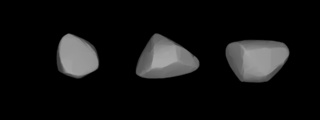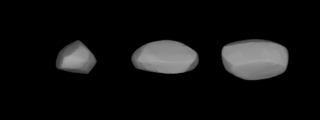Related Research Articles
2159 Kukkamäki, provisional designation 1941 UX, is a stony asteroid from the inner region of the asteroid belt, approximately 11 kilometers in diameter. It was discovered on 16 October 1941, by Finnish astronomer Liisi Oterma at Turku Observatory in Southwest Finland. It was later named after Finnish geodesist Tauno Kukkamäki.
2072 Kosmodemyanskaya, provisional designation 1973 QE2, is a stony asteroid from the inner regions of the asteroid belt, approximately 6 kilometers in diameter.
1024 Hale, provisional designation A923 YO13, is a carbonaceous background asteroid from the outer regions of the asteroid belt, approximately 45 kilometers (28 miles) in diameter. The asteroid was discovered on 2 December 1923, by Belgian–American astronomer George Van Biesbroeck at the Yerkes Observatory in Wisconsin, United States. It was named for American astronomer George Ellery Hale. The dark C-type asteroid may have a rotation period of 16 hours.
1168 Brandia, provisional designation 1930 QA, is a stony Eunomian asteroid from the central regions of the asteroid belt, approximately 10 kilometers in diameter. Discovered by astronomer Eugène Delporte at Uccle Observatory in 1930, the asteroid was later named after mathematician Eugène Brand.
3212 Agricola, provisional designation 1938 DH2, is a stony Flora asteroid from the inner regions of the asteroid belt, approximately 5 km (3.1 miles) in diameter. It was discovered by Finnish astronomer Yrjö Väisälä at Turku Observatory in Southwest Finland, on 19 February 1938, and named after reformer Mikael Agricola.

1957 Angara is a stony Eos asteroid from the outer regions of the asteroid belt, approximately 18 kilometers in diameter. It was discovered on 1 April 1970, by Soviet astronomer Lyudmila Chernykh at the Crimean Astrophysical Observatory in Nauchnyj, and named after the Siberian Angara River.
1541 Estonia, provisional designation 1939 CK, is an asteroid from the central regions of the asteroid belt, approximately 21 kilometers in diameter. It was discovered on 12 February 1939, by astronomer Yrjö Väisälä at the Iso-Heikkilä Observatory near Turku, Finland. The asteroid was named after the Baltic country of Estonia.
1722 Goffin, provisional designation 1938 EG, is a stony asteroid from the central region of the asteroid belt, approximately 10.3 kilometers in diameter.
1479 Inkeri, provisional designation 1938 DE, is an asteroid from the central regions of the asteroid belt. It is an exceptionally slow rotator, suspected tumbler and measures approximately 19 kilometers in diameter. It was discovered on 16 February 1938, by Finnish astronomer Yrjö Väisälä at the Iso-Heikkilä Observatory in Turku, Finland. "Inkeri" is the name of two of the discoverer's younger relatives as well as the local name of the former Finnish province of Ingria.
1522 Kokkola, provisional designation 1938 WO, is a stony Vestian asteroid from the inner regions of the asteroid belt, approximately 9.5 kilometers in diameter. It was discovered on 18 November 1938, by pioneering Finnish astronomer Liisi Oterma at Turku Observatory in Southwest Finland. It was later named for the town of Kokkola.
1473 Ounas, provisional designation 1938 UT, is a stony asteroid, suspected tumbler and a slow rotator from the middle region of the asteroid belt, approximately 18 kilometers in diameter. It was discovered on 22 October 1938, by Finnish astronomer Yrjö Väisälä at Turku Observatory in Southwest Finland. The asteroid was named after the Finnish Ounas river.
1536 Pielinen, provisional designation 1939 SE, is a stony Florian asteroid from the inner regions of the asteroid belt, approximately 7.8 kilometers in diameter. It was discovered on 18 September 1939, by Finnish astronomer Yrjö Väisälä at Turku Observatory, Southwest Finland. It was later named for Finnish lake Pielinen.
1646 Rosseland, provisional designation 1939 BG, is a stony asteroid from the inner regions of the asteroid belt, approximately 12 kilometers in diameter. It was discovered on 19 January 1939, by Finnish astronomer Yrjö Väisälä at Turku Observatory in Southwest Finland. It was later named after Norwegian astrophysicist Svein Rosseland.

1518 Rovaniemi, provisional designation 1938 UA, is a stony Florian asteroid from the inner regions of the asteroid belt, approximately 8 kilometers in diameter. Discovered by Yrjö Väisälä at the Turku Observatory in 1938, the asteroid was later named after the Finnish city of Rovaniemi.
1979 Sakharov, provisionally designated 2006 P-L, is a stony Vestian asteroid from the inner regions of the asteroid belt, approximately 4.5 kilometers in diameter. It was discovered during the Palomar–Leiden survey in 1960, and named after Russian physicist Andrei Sakharov.
1405 Sibelius, provisional designation 1936 RE, is a stony Florian asteroid from the inner regions of the asteroid belt, approximately 8 kilometers in diameter. It was discovered on 12 September 1936, by Finnish astronomer Yrjö Väisälä at Turku Observatory in Southwest Finland. The asteroid was named after composer Jean Sibelius.

1927 Suvanto, provisional designation 1936 FP, is a stony Eunomian asteroid from the central region of the asteroid belt, approximately 12 kilometers in diameter. It was discovered on 18 March 1936, by Finnish astronomer Rafael Suvanto at the Turku Observatory in Southwest Finland. The asteroid was posthumously named in honor of the discoverer.

1496 Turku, provisional designation 1938 SA1, is a Florian asteroid from the inner regions of the asteroid belt, approximately 8 kilometers in diameter. It was discovered on 22 September 1938, by astronomer Yrjö Väisälä at the Iso-Heikkilä Observatory in Turku, Finland. The asteroid was named for the Finnish city of Turku.

1289 Kutaïssi is a stony Koronian asteroid from the outer region of the asteroid belt. Discovered by Grigory Neujmin at Simeiz Observatory in 1933, it was later named after the Georgian city of Kutaisi. The S-type asteroid has a rotation period of 3.6 hours and measures approximately 22 kilometers in diameter.
1573 Väisälä, provisional designation 1949 UA, is a stony Phocaea asteroid, slow rotator and suspected tumbler from the inner regions of the asteroid belt, approximately 9 kilometers in diameter. It was discovered on 27 October 1949, by Belgian astronomer Sylvain Arend at the Royal Observatory of Belgium in Uccle, Belgium. It was named for Finnish astronomer Yrjö Väisälä.
References
- 1 2 3 4 5 "JPL Small-Body Database Browser: 1928 Summa (1938 SO)" (2017-02-08 last obs.). Jet Propulsion Laboratory . Retrieved 2 July 2017.
- 1 2 3 Schmadel, Lutz D. (2007). "(1928) Summa". Dictionary of Minor Planet Names – (1928) Summa. Springer Berlin Heidelberg. p. 155. doi:10.1007/978-3-540-29925-7_1929. ISBN 978-3-540-00238-3.
- 1 2 3 4 5 6 "LCDB Data for (1928) Summa". Asteroid Lightcurve Database (LCDB). Retrieved 5 April 2017.
- 1 2 3 4 Mainzer, A.; Grav, T.; Masiero, J.; Hand, E.; Bauer, J.; Tholen, D.; et al. (November 2011). "NEOWISE Studies of Spectrophotometrically Classified Asteroids: Preliminary Results". The Astrophysical Journal. 741 (2): 25. arXiv: 1109.6407 . Bibcode:2011ApJ...741...90M. doi:10.1088/0004-637X/741/2/90.
- 1 2 3 Masiero, Joseph R.; Mainzer, A. K.; Grav, T.; Bauer, J. M.; Cutri, R. M.; Dailey, J.; et al. (November 2011). "Main Belt Asteroids with WISE/NEOWISE. I. Preliminary Albedos and Diameters". The Astrophysical Journal. 741 (2): 20. arXiv: 1109.4096 . Bibcode:2011ApJ...741...68M. doi:10.1088/0004-637X/741/2/68 . Retrieved 5 April 2017.
- 1 2 Hills, Kevin (January 2013). "Asteroid Lightcurve Analysis at Riverland Dingo Observatory (RDO): 501 Urhixidur, 1897 Hind, 1928 Summa, 6261 Chione, and (68216) 2001 CV 26". The Minor Planet Bulletin. 40 (1): 12–13. Bibcode:2013MPBu...40...12H. ISSN 1052-8091 . Retrieved 5 April 2017.
- 1 2 Owings, Larry E. (April 2013). "Lightcurves for 1560 Strattonia, 1928 Summa, 2763 Jeans, 3478 Fanale, 3948 Bohr, 5275 Zdislava, and 5369 Virgiugum". The Minor Planet Bulletin. 40 (2): 104–106. Bibcode:2013MPBu...40..104O. ISSN 1052-8091 . Retrieved 5 April 2017.
- 1 2 3 4 Binzel, R. P. (October 1987). "A photoelectric survey of 130 asteroids". Icarus. 72 (1): 135–208. Bibcode:1987Icar...72..135B. doi:10.1016/0019-1035(87)90125-4. ISSN 0019-1035 . Retrieved 5 April 2017.
- ↑ Veres, Peter; Jedicke, Robert; Fitzsimmons, Alan; Denneau, Larry; Granvik, Mikael; Bolin, Bryce; et al. (November 2015). "Absolute magnitudes and slope parameters for 250,000 asteroids observed by Pan-STARRS PS1 - Preliminary results". Icarus. 261: 34–47. arXiv: 1506.00762 . Bibcode:2015Icar..261...34V. doi:10.1016/j.icarus.2015.08.007 . Retrieved 5 April 2017.
- 1 2 "1928 Summa (1938 SO)". Minor Planet Center. Retrieved 5 April 2017.
- ↑ "MPC/MPO/MPS Archive". Minor Planet Center. Retrieved 5 April 2017.